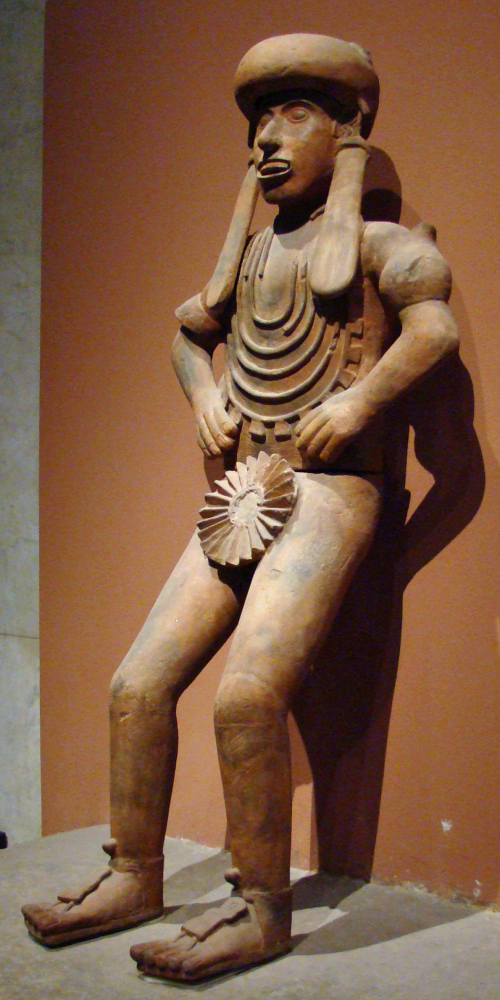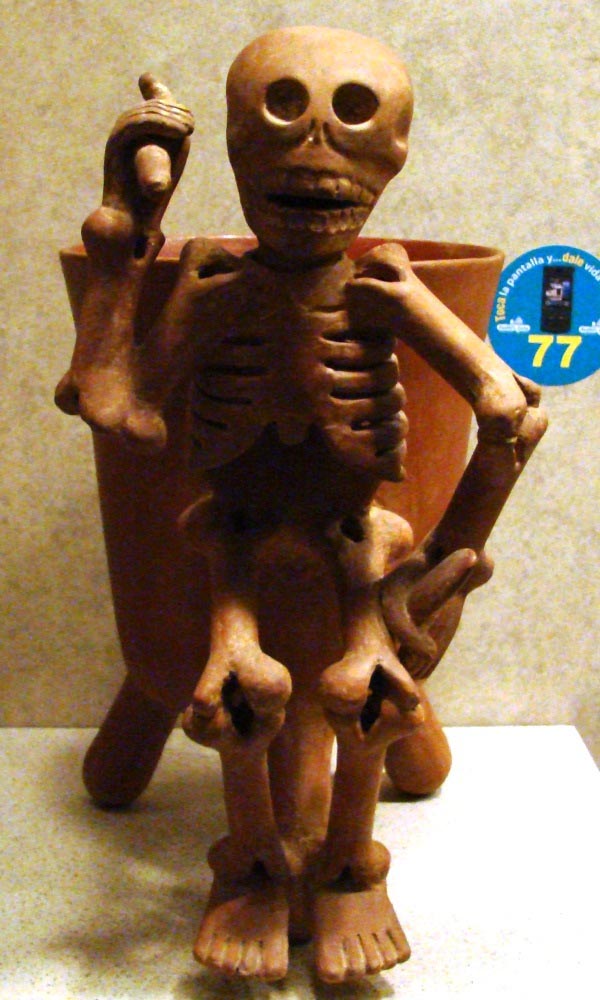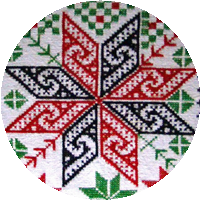The Lands of the Dead
Please click any thumbnail at right for a larger image!
Click any highlighted name to hear its pronunciation!
Perhaps the most provocative detail about the Mesoamerican afterlife is that, though it often had a complex geography with multiple realms, one's final destiny depended more on how they died rather than how they lived. Moral and ritual behavior did have their place in religious life, but they concerned keeping the social and natural worlds healthy for present and future generations. The afterlife was more like an afterthought in matters of personal morality.
In the Aztec world one of the most pleasant places to go was Tlalocan, the 'Place of Tlaloc,' the rain god. While in many Old World religions Paradise was reckoned to be in the sky, the Aztec concept was deep beneath the earth, for Tlaloc was himself 'covered in earth.' People who died by drowning, lightning, edema, or other water-related calamities would arrive in Tlalocan, a watery realm with vibrant gardens and ample amenities. Although this mural from Teotihuacan may not represent such a place, its imagery is very similar to how the Aztecs envisioned the realm.
National Museum of Anthropology and History
Most commoners, however, died regular deaths and thus took the road to Mictlan, 'Land of Death.' The Aztec view of this path was bleak. It took four years for the deceased spirit to descend, with many perilous ordeals such as crushing mountains and flying knives. The path was northbound, toward the cold Chichimeca desert lands, and it was also downward, levels deeper into the earth. At last the ninth and final destination was Mictlan proper, a cavern of sooty winds and constant darkness, resided over by the divine couple Mictecacihuatl and Mictlanteuctli, the latter presented here as a ceramic with terrible immensity and as a cup with stern gaze. Even Aztec emperors would eventually arrive in Mictlan, where their spirits would dwell alongside their subjects'.
Aztec Great Temple Museum
While most of the life-sized sculptures in Aztec art depicted gods and goddesses, human figures could occasionally appear. Both of these ceramic sculptures portray priests dedicated to Mictlanteuctli. Their accoutrements include hanging ear ribbons and pleated fans with a tall cone, both characteristic of the underworld god. (Compare, for example, the ribbon earrings in the stone Mictlanteuctli cup above and the central stone Cihuateotl below.) These are excellent examples how Mesoamerican priests dressed precisely like the deities they attended.
National Museum of Anthropology and History
Even after death the spirits could continue to operate in the world, with the dual potential for benefit or harm. Among the most infamous of the deceased spirits in the Aztec world were the Cihuateteoh or 'woman spirits,' the souls of women who had died in childbirth. Male Aztec warriors who died in battle for the empire were believed to earn one of the most glorious afterlife rewards, to transform into eagles or butterflies in the sky and help raise the sun from the underworld to the zenith. Likewise, the Cihuateteoh were women who had died in "battle" over life, and they helped carry the sun from the zenith back to the earth's surface as it returned into the underworld by dusk. They, too, transformed into sky spirits, but they were dark and wrathful creatures to be avoided, especially by young children they would jealously attack on specific days of the ritual calendar.
National Museum of Anthropology and History
These are two magnificent examples from El Zapotal, Veracruz, which had a unique monument in ancient Mesoamerica: a model of the underworld with a retinue of nineteen Cihuateteoh women spirits in nearly life-sized standing ceramics. Several of them stood in a frozen line toward the model's centerpiece, a shrine dedicated to the underworld god with his life-sized ceramic sculpture seated upon its throne. These two ceramic ladies are embellished with details of splendid jewelry, ornate headdresses, and two-headed serpents (worn as belts). The sculpture at left wears a headdress with a wonderfully crafted bat and flowing hood. The one at right presents an oval emblem in front of her headdress that resembles an ancient sign for the heart and life.
Xalapa Museum of Anthropology
And upon the center of the great underworld model at Zapotal sat its majestic lord, ensconced upon a throne of skulls. This outdoor replica recreates the lavish paintings that surrounded the throne, themselves depicting a procession of supernatural beings such as an elderly pregnant woman and coyote-pelt warrior. These two are to the immediate left and right of the throne, respectively, in the detail at right. Richard Diehl described how the entire setup of murals and ceramics recreates a narrative of the sun's nightly movement through the underworld.
National Museum of Anthropology and History
A noteworthy detail in many renditions of the underworld lord is that, while most of the body is a bare skeleton, other parts have live tissue. The tall Mictlanteuctli ceramic above, for example, has an impressive liver hanging beneath its ribcage. Both the Zapotal Mictlanteuctli sculpture and this miniature ceramic skeleton have fleshy hands and feet, implying that the underworld god had qualities of both the living and the dead. This ceramic image of the underworld god was made by the Zapotec, who called him Yya Dzandaya. The hands hold a sacrificial knife and what appears to be a deer antler, both used to perform rituals. Also, the head could turn on a socket at the neck! This brought further liveliness to an otherwise "dead" figurine.
National Museum of Anthropology and History
One of the most elaborate descriptions of the underworld in Mesoamerica comes from the Popol Vuh or '(Council) Mat Book,' the mythical epic of the K'ichee' Maya in western Guatemala. Xibalbá is K'ichee' for 'Place of Awe / Fright,' which concisely summarizes the experience of its deep spirit worlds. It was a major arena for the adventures of the myth's Hero Twins, who endured a series of trials and traps across a series of houses within the underworld. The twins use magic to outwit their infernal hosts, the Ajawab' 'Lords' of Xibalbá, whose defeat protected the earth from their capricious killings. One of the lords appears in the vase at right: he sits upon a throne bedecked with crossbones, and his jaguar jaw highlights his otherworldly quality.
Despite the terrible nature of the Maya underworld, it was still a field of power for the priests and kings who knew how to brave it. For Xibalbá was a land for not only the dead and their lords but also for the waayob', the nagual animal spirits that accompanied the living. In the trance or dream state, the religious specialist could take an out-of-body experience as the soul swam through the underworld, with greater ease once it transformed into its animal waay. On the ceramic bowl at left are two of these companion spirits, the one on the left spreading his crossbones cape like bat wings.
Popol Vuh Museum, Museum of Fine Arts














